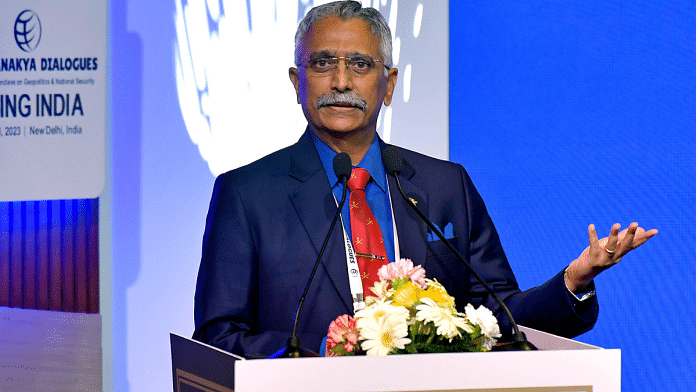New Delhi: India’s former Army chief General Manoj Mukund Naravane (Retd) Friday said that history shows that “no one has ever won a two-front war” and stressed the role of diplomacy in preventing or resolving conflicts with India’s neighbours, particularly Pakistan and China.
Gen. Naravane was talking at the 12th lecture of the ‘India International Centre and Press Club of India Conversations’ series that started in January this year.
He said that there was a difference between a ‘two-front threat’ and a ‘two-front war’. The former refers to the potential challenges posed by China and Pakistan to India’s security and interests, while the latter implies an actual simultaneous outbreak of hostilities on both sides of India’s borders.
According to Gen. Naravane, India faces a ‘two-front threat’ but does not want to fight a ‘two-front war’. “No one who has fought a two-front war has ever won,” he added.
Stressing the role of diplomacy, he said that it was key to ensuring peace and stability in the region. “War is not only the responsibility of the armed forces but of the whole nation. All our agencies are involved,” he said.
Citing an example of how India managed to avoid a confrontation with China during the 1971 war with Pakistan, which led to the creation of Bangladesh, he said that China did not mobilise at the time “because we had an agreement with Russia. Indira Gandhi had gone to Russia.”
He also discussed how India would deal with a hypothetical two-front war if it ever occurred. “In case of such a war, there will always be primary and secondary fronts. The primary front will have all our assets and resources there, while at the secondary front, we’ll have a deterrent capability to keep it quiet.”
Also Read: Formed in 2021, 7 new defence PSUs to see steep decline in orders, finds Parliament panel
‘Boots on the ground to stay’
Gen. Naravane further discussed how the character of warfare was changing due to technological advancements, but its nature remained the same.
“With technology development, there was a feeling that wars will be non-contact and two adversaries will attack each other’s cyber hubs and victory will be declared. It was said that it will be non-contact and you will only fire missiles from one side to another, although missiles will still result in deaths and destruction,” he said.
However, he added that conflicts such as the one between Russia and Ukraine had shown that this was not true. He asserted that contact warfare would continue to be relevant, as adversaries would still face each other on the ground. “That is not going to change.”
Highlighting the role new technology will play in transforming the armed forces, he said, as technology comes in, “we will move from being a manpower-intensive to a technologically oriented force.”
Nevertheless, he added, “Given the character of warfare, boots on the ground will always be there and you cannot do away with that no matter how much technology we have.”
“Only with boots on the ground can you claim the territory as yours. That is exactly what is happening between Russia and Ukraine,” he added.
He went on to say that technology was only an aid, not a replacement, for the “horror that is war”. Therefore, “war should be avoided at all costs and as far as possible”.
Nature vs character of war
The general made a distinction between the nature of war and the character of war. The former, he said, was the fighting itself, which involved bloodshed and killing. The character of war, on the other hand, is the manner in which wars are fought.
“The Nature of war does not change over the years and it has graduated from clubs and spears to gunpowder, rifles and cavalry, moving onto artillery, tanks, aircraft,” he said.
To be realistic, therefore, it was important to accept that the weapons and weapon systems in use today will not continue to be in use or be as effective a few years down the line, he said.
Citing examples of how some companies had failed or succeeded in adapting to new technologies, he said Kodak had gone bankrupt because it did not embrace digital photography.
“Kodak failed to adapt by not going digital. They stuck to prints and today they are nowhere to be heard of. But, on the other hand, Canon adapted and went digital, and now they are everywhere,” said Gen. Naravane.
According to him, this does not mean that some weapons systems will become obsolete. “Even if aircraft, tanks and ships become unmanned, they will still exist, but without a human operator. Many of these things are already being developed with no crew or human element.”
According to him, technology will certainly change the way we operate. “We will be more dispersed, camouflage concealment and passive measures will be taken to avoid detection by various surveillance means. But all this will be at the tactical level. War will remain the same,” he said.
(Edited by Richa Mishra)



